Nestled between rocks and boulders near the top of Chilkoot Pass are over 50 bundles. Most bundles consist of canvas wrapped around pieces of wood. Though they initially appear to be tents or bedrolls, they are canvas boats, long abandoned 16 miles from the ocean, over 3000 ft above sea level on a mountain pass.
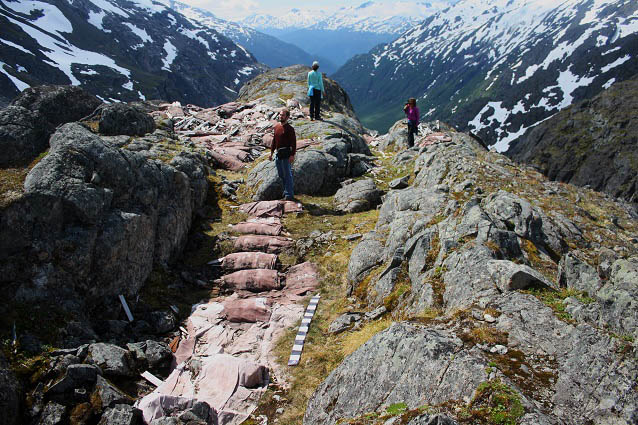
NPS photo
What are they?
These artifacts are canvas "knockdown" boats, abandoned during the Klondike Gold Rush.
Where are they?
The boats are located on a knoll just east of the Chilkoot Trail, north of the false summit and east of the Centennial marker. The boats are a popular side trip for Chilkoot hikers, but may be covered with snow even during the summer.
Description
There are remains for over eighty boats. Originally each boat consisted of pieces of wood and hardware tightly wrapped in canvas. Bundles are about 30 inches wide and 3-5ft long, but vary greatly based on condition. Today many of the boats are still well wrapped, but some have been unraveled and spread about. Though the bundles are weathered from over a century in the elements they are in reasonably good shape due to preservation efforts by the park, visitors looking but not touching them, and the microclimate and snow pack where they are found.

NPS photo
Whose boats are these?
While the origin of these boats isn't known for sure, it seems likely they may have belonged to Flowers, Smith and Company who arrived in the area in December of 1897. John M. Flowers helped locate and lay out the townsite at Lake Lindeman. By early January 1898 Flowers, Smith and Company had built a dock and warehouse at Lindeman as just one part of the company's endeavours which also included selling canvas and three-piece metal sectional boats to stampeders.
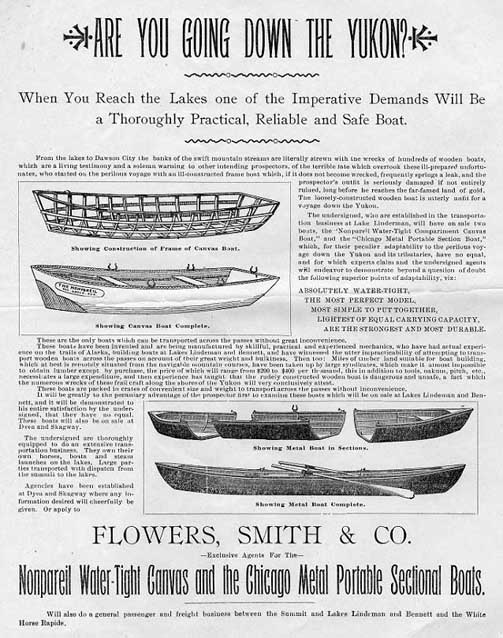
National Park Service, Klondike Gold Rush National Historical Park, George and Edna Rapuzzi Collection, KLGO 58269. Gift of the Rasmuson Foundation.
Historian Frank Norris writes:
- Advertisements blared the virtues of the company's canvas boats. They were called "non pareil canvas compartment boats." These one person boats, when constructed, were approximately 17 and one half foot long, with a beam of five feet. Because these boats were to be placed on sale at Dyea and Skagway as well as the lakes, their compact shape and light weight were advertised." These boats," it claimed, "are packed in crates of convenient size and weight to transport across the passes without inconvenience." Their sturdiness and maneuverability vis-à-vis scows and other wooden boats were also highly touted. The company originally possessed 232 of the canvas boats.
While they may have started with 232 canvas boats, only some of those boats ended up near the Chilkoot summit. The exact number of boats cached is uncertain. Estimates from the 1960s to now have ranged from 50 to "nearly 200" boats. It is also unclear why these boats were left where they are. One explanation is that John Flowers and his partners were evicted from Lindeman City in the winter of 1898 and forced to continue their businesses on the Dyea side of the Chilkoot Pass. Without the lake-front property it probably wasn't worth the hassle to transport these boats any farther and thus were abandoned. Chilkoot Pass can have snow any month of the year, and certainly in the winter of 1898 they would have quickly been covered with snow and forgotten and hidden from other stampeders.
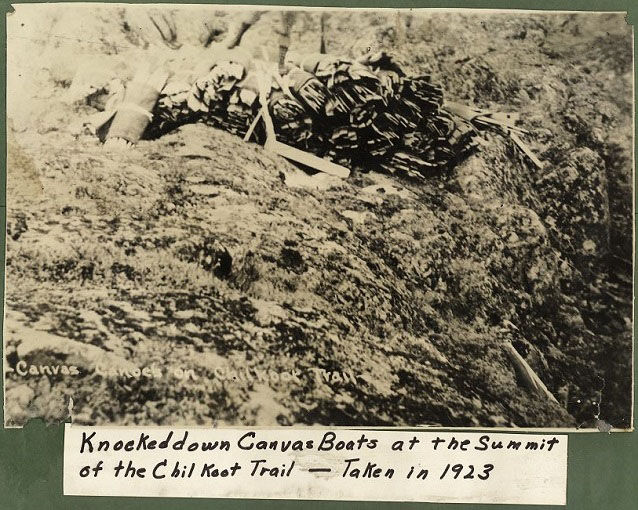
National Park Service, Klondike Gold Rush National Historical Park, George and Edna Rapuzzi Collection, KLGO 60225. Gift of the Rasmuson Foundation. This image is cropped from the larger displayed artifact.

Frontiersman, August 17, 1967
In the late 1960s, a group of inmates working on Chilkoot Trail improvements received permission from the Alaska Governor, Walter J. Hickel, to remove a few of the boats from the summit. In 1967 about a dozen boats were removed from the summit and distributed to museums around Alaska as well as the Smithsonian Institue and the National Geographic Society.
It was around this time that one of the boats was gifted to George Rapuzzi for his Jeff. Smiths Parlor museum. George had provided the inmate crews with some information about the boats including showing a photograph he'd taken in 1923. The boat he received was displayed in the museum for years and today is part of the park's George and Edna Rapuzzi collection.
In 1976 Klondike Gold Rush National Historical Park was formed and much of the Chilkoot Trail became part of the park. In 1978, in an effort to find more information about these boats, the National Park Service reached out to the public through Alaska magazine. A number of people wrote letters to the park including some of the supervisors from the inmate groups. Ultimately two boats were examined by the National Park Service Division of Museum Services who carefully unwrapped the bundles. In a memo on the boats they describe
- "[t]he canvas was stuck together. The waterproofing material had become sticky at some time and adhered to the next layer. The canvas had been folded to a three foot width and rolled around part of the disassembled wooden structure...The canvas was rotted very badly where it laid on the ground."
They counted a total of 72 pieces of wood frame and one large piece of canvas. Rotted pieces of wood were duplicated and the canvas was measured and recreated with fresh material. The team then assembled one of the boats. On the rib assembly process the memo notes "[w]e can't explain how this would have been done originally, unless the wood was green and could be bent." In the end the team produced a constructed canvas boat that appears larger than suggested by the bundle of canvas and wood. Somewhat mysteriously though, they had an extra piece left over.
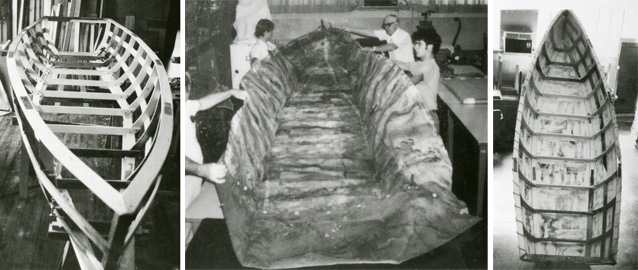
NPS photos
Over the years, archeologists have continued to monitor these artifacts for looting, damage, and degradation. Today, because the the cache of canvas boats is in the same position (in situ) as the gold rush, they make a fun and intriguing side trip for people hiking the Chilkoot Trail. If you visit, please remember to enjoy this place without touching or disturbing the artifacts.
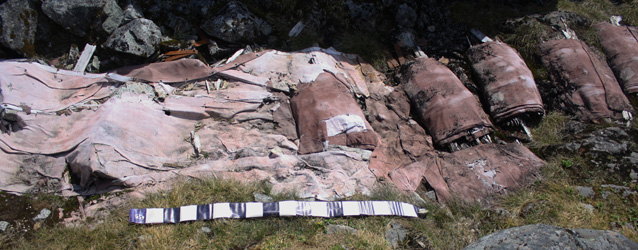
NPS photo
Some of this text was adapted from a short note written by NPS historian Frank Norris in 1986.
Last updated: October 23, 2021
